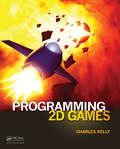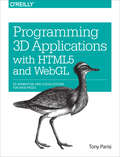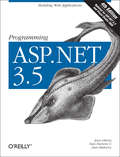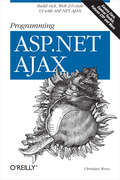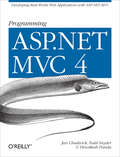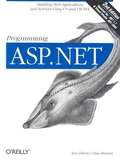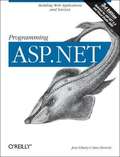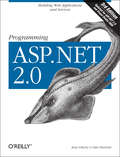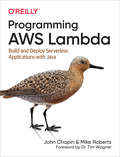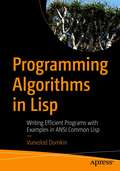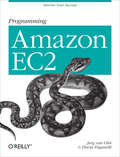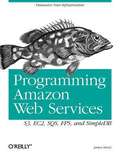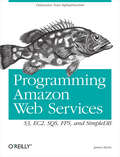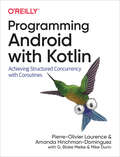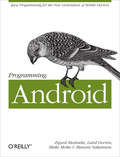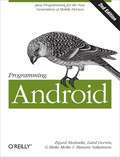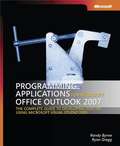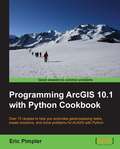- Table View
- List View
Programming 2D Games
by Charles KellyA First Course in Game ProgrammingMost of today's commercial games are written in C++ and are created using a game engine. Addressing both of these key elements, Programming 2D Games provides a complete, up-to-date introduction to game programming. All of the code in the book was carefully crafted using C++. As game programming techniques are intro
Programming 3D Applications with HTML5 and WebGL: 3D Animation and Visualization for Web Pages
by Tony ParisiCreate high-performance, visually stunning 3D applications for the Web, using HTML5 and related technologies such as CSS3 and WebGL—the emerging web graphics standard. With this book, you’ll learn how to use the tools, frameworks, and libraries for building 3D models and animations, mind-blowing visual effects, and advanced user interaction in both desktop and mobile browsers.In two parts—Foundations and Application Development Techniques—author Tony Parisi provides a thorough grounding in theory and practice for designing everything from a simple 3D product viewer to immersive games and interactive training systems. Ideal for developers with Javascript and HTML experience.Explore HTML5 APIs and related technologies for creating 3D web graphics, including WebGL, Canvas, and CSSWork with the popular JavaScript 3D rendering and animation libraries Three.js and Tween.jsDelve into the 3D content creation pipeline, and the modeling and animation tools for creating killer 3D contentLook into several game engines and frameworks for building 3D applications, including the author’s Vizi frameworkCreate 3D environments with multiple objects and complex interaction, using examples and supporting codeExamine the issues involved in building WebGL-based 3D applications for mobile browsers
Programming ASP.NET 3.5, Fourth Edition
by Jesse Liberty Dan Hurwitz Dan MaharryWith Programming ASP.NET 3.5, you'll quickly learn to create state-of-the-art applications using Microsoft's popular web development technology and Visual Studio 2008. This updated bestseller provides comprehensive and easy-to-understand information to help you use several .NET 3.5 technologies for faster development and better web application performance-including ASP.NET AJAX for interactive user interfaces, LINQ for data access, and Windows Communication Foundation (WCF) for web services. Programming ASP.NET 3.5 includes examples and sample code that let you explore development with ASP.NET in more depth. With this book, you will: * Learn about AJAX and ASP.NET server controls included with Visual Studio 2008 * Discover how to use the DataSource and data-bound controls in ADO.NET * Use the new LINQ API and learn how to make use of it within ASP.NET pages * Create a uniform look and feel throughout your application with Master Pages * Use navigation controls to build site maps, menus, and breadcrumbs quickly and easily * Build and use various web services with WCF * Detect errors during development and handle them in your production code * Learn how to configure and deploy your website Written by Microsoft technology experts Jesse Liberty, Dan Hurwitz, and Dan Maharry, Programming ASP.NET 3.5 is the best book for learning how to build dynamic, interactive web applications using Microsoft's latest technologies.
Programming ASP.NET 3.5: Building Web Applications
by Jesse Liberty Dan Hurwitz Dan MaharryWith Programming ASP.NET 3.5, you'll quickly learn to create state-of-the-art applications using Microsoft's popular web development technology and Visual Studio 2008. This updated bestseller provides comprehensive and easy-to-understand information to help you use several .NET 3.5 technologies for faster development and better web application performance-including ASP.NET AJAX for interactive user interfaces, LINQ for data access, and Windows Communication Foundation (WCF) for web services.Programming ASP.NET 3.5 includes examples and sample code that let you explore development with ASP.NET in more depth. With this book, you will: Learn about AJAX and ASP.NET server controls included with Visual Studio 2008 Discover how to use the DataSource and data-bound controls in ADO.NET Use the new LINQ API and learn how to make use of it within ASP.NET pages Create a uniform look and feel throughout your application with Master Pages Use navigation controls to build site maps, menus, and breadcrumbs quickly and easily Build and use various web services with WCF Detect errors during development and handle them in your production code Learn how to configure and deploy your website Written by Microsoft technology experts Jesse Liberty, Dan Hurwitz, and Dan Maharry, Programming ASP.NET 3.5 is the best book for learning how to build dynamic, interactive web applications using Microsoft's latest technologies.
Programming ASP.NET AJAX
by Christian WenzDelivering rich, Web 2.0-style experiences has never been easier. This book gives you a complete hands-on introduction to Microsoft ASP.NET AJAX 1.0, the new framework that offers many of the same benefits for Ajax development that ASP.NET provides for server-side development. With Programming ASP.NET AJAX, you'll learn how to create professional, dynamic web pages with Ajax in no time. Loaded with code and examples that demonstrate key aspects of the framework, this book is ideal not only for ASP.NET developers who want to take their applications a step further with Ajax, but for any web developers interested in ASP.NET AJAX, no matter what technology they use currently. That includes JavaScript programmers who would like to avoid the headaches of writing cross-browser code.Programming ASP.NET AJAX offers you: A high-level overview of the ASP.NET AJAX framework Functional code that you can cut and paste for use in your own applications The essentials of JavaScript and Ajax to help you understand individual technologies used by the framework An organization that reflects the framework's packages, including Extensions, Control Toolkit, the Futures CTP, and the AJAX Library Sidebars throughout the book that identify and propose solutions to potential security breaches Ways to use the standards-based AJAX Library with other platforms, such as PHP A complete chapter on the UpdatePanel control for making individual parts of a web page independently updateable -- one of the framework's most important elements Released previously as Programming Atlas to cover the beta version of the Microsoft framework, this edition is fully up-to-date and expanded for the official 1.0 release of ASP.NET AJAX. Written by Christian Wenz -- Microsoft MVP for ASP/ASP.NET and AJAX Control Toolkit Contributor -- Programming ASP.NET AJAX contains many hard-to-find details, along with a few unofficial ways to accomplish things.
Programming ASP.NET MVC 4: Developing Real-World Web Applications with ASP.NET MVC
by Hrusikesh Panda Jess Chadwick Todd SnyderGet up and running with ASP.NET MVC 4, and learn how to build modern server-side web applications. This guide helps you understand how the framework performs, and shows you how to use various features to solve many real-world development scenarios you’re likely to face. In the process, you’ll learn how to work with HTML, JavaScript, the Entity Framework, and other web technologies.You’ll start by learning core concepts such as the Model-View-Controller architectural pattern, and then work your way toward advanced topics. The authors demonstrate ASP.NET MVC 4 best practices and techniques by building a sample online auction site ("EBuy") throughout the book.Learn the similarities between ASP.NET MVC 4 and Web FormsUse Entity Framework to create and maintain an application databaseCreate rich web applications, using jQuery for client-side developmentIncorporate AJAX techniques into your web applicationsLearn how to create and expose ASP.NET Web API servicesDeliver a rich and consistent experience for mobile devicesApply techniques for error handling, automated testing, and build automationUse various options to deploy your ASP.NET MVC 4 application
Programming ASP.NET, 2nd Edition
by Jesse Liberty Dan HurwitzIn Programming ASP.NET , Second Edition authors Jesse Liberty and Dan Hurwitz cover everything you need to know to be effective with ASP.NET. The book includes a comprehensive tutorial on Web Forms, which, in conjunction with Visual Studio .NET 2003, allow you to apply Rapid Application Development techniques (including drag-and-drop control placement) to web development. Programming ASP.NET includes extensive coverage of each type of server control, including Web server controls, HTML server controls, and custom controls. New material covers creating ASP.NET pages for mobile devices.
Programming ASP.NET, 3rd Edition
by Jesse Liberty Dan HurwitzO'Reilly has once again updated its bestselling tutorial on ASP.NET, the world's leading web development tool from Microsoft. In Programming ASP.NET , Third Edition, author Jesse Liberty gives you the lowdown on the technology's latest version, ASP.NET 2.0, as well as Visual Studio 2005. One of the most significant improvements to ASP.NET 2.0 is its intuitive nature. In fact, when compared to its predecessor, ASP.NET 2.0 reduces the amount of code you have to write by about 75%. Creating interactive web applications has never been easier-but that still doesn't mean it's hassle-free! The difficulty in ASP.NET 2.0 is that it's so complete and flexible that there are many pieces that must be woven together to build a robust, scalable, and efficient application. Fortunately, Programming ASP.NET , Third Edition is on the case, dispensing all the information you need to be effective with this dynamic tool. For starters, the book features a comprehensive tutorial on Web Forms, the user interface that gives web applications their look and feel. It then offers detailed explanations of all new controls, including Web server controls, HTML controls, and custom controls. Used properly, these controls are able to take care of nearly all the foundation work-security, data access, layout, etc.-that you would normally have to write yourself. Free of these burdensome tasks, you can instead focus on your specific application. Other new material found in this updated edition even shows you how to create ASP.NET 2.0 pages for mobile devices. With Programming ASP.NET , Third Edition at your side, there's virtually no end to the programming possibilities.
Programming ASP.NET: Building Web Applications and Services with ASP.NET 2.0
by Jesse Liberty Dan HurwitzO'Reilly has once again updated its bestselling tutorial on ASP.NET, the world's leading web development tool from Microsoft. In Programming ASP.NET, Third Edition, authors Jesse Liberty and Dan Hurwitz give you the lowdown on the technology's latest version, ASP.NET 2.0, as well as Visual Studio 2005.Among the most significant improvements to ASP.NET 2.0 are new server controls and services that make you dramatically more productive. In fact, when compared to its predecessor, ASP.NET 2.0 reduces the amount of code you have to write by about 75%. Creating interactive web applications has never been easier-but that still doesn't mean it's hassle-free! The difficulty in ASP.NET 2.0 is that it's so complete and flexible that there are many pieces that must be woven together to build a robust, scalable, and efficient application.Fortunately, Programming ASP.NET, Third Edition is on the case, dispensing all the information you need to be effective with this dynamic tool. For starters, the book features a comprehensive tutorial on Web Forms, the user interface that gives web applications their look and feel. It then offers detailed explanations of all new controls, including web server controls, HTML controls, and custom controls. Used properly, these controls are able to take care of nearly all the foundation work-security, data access, layout, etc.-that you would normally have to write yourself. Free of these burdensome tasks, you can instead focus on your specific application.Other new material found in this updated edition even shows you how to create ASP.NET 2.0 pages for mobile devices. With Programming ASP.NET, Third Edition at your side, there's virtually no end to the programming possibilities.
Programming AWS Lambda: Build and Deploy Serverless Applications with Java
by Mike Roberts John ChapinServerless revolutionizes the way organizations build and deploy software. With this hands-on guide, Java engineers will learn how to use their experience in the new world of serverless computing. You’ll discover how this cloud computing execution model can drastically decrease the complexity in developing and operating applications while reducing costs and time to market.Engineering leaders John Chapin and Mike Roberts guide you through the process of developing these applications using AWS Lambda, Amazon’s event-driven, serverless computing platform. You’ll learn how to prepare the development environment, program Lambda functions, and deploy and operate your serverless software. The chapters include exercises to help you through each aspect of the process.Get an introduction to serverless, functions as a service, and AWS LambdaLearn how to deploy working Lambda functions to the cloudProgram Lambda functions and learn how the Lambda platform integrates with other AWS servicesBuild and package Java-based Lambda code and dependenciesCreate serverless applications by building a serverless API and data pipelineTest your serverless applications using automated techniquesApply advanced techniques to build production-ready applicationsUnderstand both the gotchas and new opportunities of serverless architecture
Programming Algorithms in Lisp: Writing Efficient Programs with Examples in ANSI Common Lisp
by Vsevolod DomkinMaster algorithms programming using Lisp, including the most important data structures and algorithms. This book also covers the essential tools that help in the development of algorithmic code to give you all you need to enhance your code.Programming Algorithms in Lisp shows real-world engineering considerations and constraints that influence the programs that use these algorithms. It includes practical use cases of the applications of the algorithms to a variety of real-world problems. What You Will LearnProgram algorithms using the Lisp programming languageWork with data structures, arrays, key-values, hash-tables, trees, graphs, and moreUse dynamic programming Program using stringsWork with approximations and compression Who This Book Is For Intermediate Lisp programmers wanting to do algorithms programming. A very experienced non-Lisp programmer may be able to benefit from this book as well.
Programming Amazon EC2: Survive your Success (Head First Ser.)
by Jurg Van Vliet Flavia PaganelliIf you plan to use Amazon Web Services to run applications in the cloud, the end-to-end approach in this book will save you needless trial and error. You'll find practical guidelines for designing and building applications with Amazon Elastic Compute Cloud (EC2) and a host of supporting AWS tools, with a focus on critical issues such as load balancing, monitoring, and automation.How do you move an existing application to AWS, or design your application so that it scales effectively? How much storage will you require? Programming Amazon EC2 not only helps you get started, it will also keep you going once you're successfully positioned in the cloud. This book is a must-read for application architects, developers, and administrators.Determine your application's lifecycle and identify the AWS tools you needLearn how to build and run your application as part of the development processMigrate simple web applications to the cloud with EC2, Amazon Simple Storage Service, and CloudFront content deliveryMeet traffic demand with EC2's Auto Scaling and Elastic Load BalancingDecouple your application using Simple Queue Service, Simple Notification Service, and other toolsUse the right tools to minimize downtime, improve uptime, and manage your decoupled system"Jurg and Flavia have done a great job in this book building a practical guide on how to build real systems using AWS."--Werner Vogels, VP & CTO at Amazon.com
Programming Amazon Web Services
by James MurtyBuilding on the success of its storefront and fulfillment services, Amazon now allows businesses to "rent" computing power, data storage and bandwidth on its vast network platform. This book demonstrates how developers working with small- to mid-sized companies can take advantage of Amazon Web Services (AWS) such as the Simple Storage Service (S3), Elastic Compute Cloud (EC2), Simple Queue Service (SQS), Flexible Payments Service (FPS), and SimpleDB to build web-scale business applications. With AWS, Amazon offers a new paradigm for IT infrastructure: use what you need, as you need it, and pay as you go. Programming Amazon Web Services explains how you can access Amazon's open APIs to store and run applications, rather than spend precious time and resources building your own. With this book, you'll learn all the technical details you need to: Store and retrieve any amount of data using application servers, unlimited data storage, and bandwidth with the Amazon S3 service Buy computing time using Amazon EC2's interface to requisition machines, load them with an application environment, manage access permissions, and run your image using as many or few systems as needed Use Amazon's web-scale messaging infrastructure to store messages as they travel between computers with Amazon SQS Leverage the Amazon FPS service to structure payment instructions and allow the movement of money between any two entities, humans or computers Create and store multiple data sets, query your data easily, and return the results using Amazon SimpleDB. Scale up or down at a moment's notice, using these services to employ as much time and space as you need Whether you're starting a new online business, need to ramp up existing services, or require an offsite backup for your home, Programming Amazon Web Services gives you the background and the practical knowledge you need to start using AWS. Other books explain how to build web services. This book teaches businesses how to take make use of existing services from an established technology leader.
Programming Amazon Web Services: S3, EC2, SQS, FPS, and SimpleDB
by James MurtyBuilding on the success of its storefront and fulfillment services, Amazon now allows businesses to "rent" computing power, data storage and bandwidth on its vast network platform. This book demonstrates how developers working with small- to mid-sized companies can take advantage of Amazon Web Services (AWS) such as the Simple Storage Service (S3), Elastic Compute Cloud (EC2), Simple Queue Service (SQS), Flexible Payments Service (FPS), and SimpleDB to build web-scale business applications.With AWS, Amazon offers a new paradigm for IT infrastructure: use what you need, as you need it, and pay as you go. Programming Amazon Web Services explains how you can access Amazon's open APIs to store and run applications, rather than spend precious time and resources building your own. With this book, you'll learn all the technical details you need to: Store and retrieve any amount of data using application servers, unlimited data storage, and bandwidth with the Amazon S3 service Buy computing time using Amazon EC2's interface to requisition machines, load them with an application environment, manage access permissions, and run your image using as many or few systems as neededUse Amazon's web-scale messaging infrastructure to store messages as they travel between computers with Amazon SQSLeverage the Amazon FPS service to structure payment instructions and allow the movement of money between any two entities, humans or computersCreate and store multiple data sets, query your data easily, and return the results using Amazon SimpleDB.Scale up or down at a moment's notice, using these services to employ as much time and space as you needWhether you're starting a new online business, need to ramp up existing services, or require an offsite backup for your home, Programming Amazon Web Services gives you the background and the practical knowledge you need to start using AWS. Other books explain how to build web services. This book teaches businesses how to take make use of existing services from an established technology leader.
Programming Android with Kotlin: Achieving Structured Concurrency with Coroutines
by G. Blake Meike Mike Dunn Pierre-Olivier Laurence Amanda Hinchman-DominguezDeveloping applications for the Android mobile operating system can seem daunting, particularly if it requires learning a new programming language: Kotlin, now Androidâ??s officialdevelopment language. With this practical book, Android developers will learn how to make the transition from Java to Kotlin, including how Kotlin provides a true advantage for gaining control over asynchronous computations.Authors Pierre-Olivier Laurence, Amanda Hinchman-Dominguez, G. Blake Meike, and Mike Dunn explore implementations of the most common tasks in native Android development, and show you how Kotlin can help you solve concurrency problems. With a focus on structured concurrency, a new asynchronous programming paradigm, this book will guide you through one of Kotlin's most powerful constructs, coroutines.Learn about Kotlin essentials and the Kotlin Collections FrameworkExplore Android fundamentals: the operating system and the application container and its componentsLearn about thread safety and how to handle concurrencyWrite sequential, asynchronous work at a low costExamine structured concurrency with coroutines, and learn how channels make coroutines communicateLearn how to use flows for asynchronous data processingUnderstand performance considerations using Android profiling toolsUse performance optimizations to trim resource consumption
Programming Android: Java Programming For The New Generation Of Mobile Devices
by G. Blake Meike Zigurd Mednieks Laird Dornin Masumi NakamuraWhat does it take to build well-engineered Android applications? Explore Android's core building blocks and APIs in depth with this authoritative guide, and learn how to create compelling apps that work on a full range of Android devices. You'll work with proven approaches to app design and implementation—including application frameworks that you can use as a starting point for your own projects.Delve into sensors, native development, 3D graphics, and many other topics, and discover how to build apps on the platform of your choice. If you're an intermediate to advanced programmer, you'll learn how to make great Android apps.Learn how to use the Android SDK with the Eclipse IDEApply advanced Java concepts regardless of your experience with the languageCreate an Android user interface that's captivating and easy to navigateUse the Fragment API for tablet user interfacesMake your application compatible with Honeycomb and earlier versionsUnderstand Android's unique database design issues and the role of SQLiteUse sensors and gestures to expand your app's input beyond just tapping and scrollingExplore Android APIs for multimedia, location, communication, NFC, and other applications
Programming Android: Java Programming for the New Generation of Mobile Devices
by G. Blake Meike Zigurd Mednieks Laird Dornin Masumi NakamuraGet thoroughly up to speed on Android programming, and learn how to create up-to-date user experiences for both handsets and tablets. With this book's extensively revised second edition, you'll focus on Android tools and programming essentials, including best practices for using Android 4 APIs. If you're experienced with Java or Objective-C, you'll gain the knowledge necessary for building well-engineered applications.Programming Android is organized into four parts:Part One helps programmers with some Java or iOS experience get off to a fast start with the Android SDK and Android programming basics.Part Two delves into the Android framework, focusing on user interface and graphics class hierarchies, concurrency, and databases. It's a solid foundation for understanding of how the most important parts of an Android application work.Part Three features code skeletons and patterns for accelerating the development of apps that use web data and Android 4 user interface conventions and APIs.Part Four delivers practical coverage of Android's multimedia, search, location, sensor, and account APIs, plus the Native Development Kit, enabling developers to add advanced capabilities.This updated edition of Programming Android focuses on the knowledge and developer priorities that are essential for successful Android development projects.
Programming Applications for Microsoft® Office Outlook® 2007
by Randy Byrne Ryan GreggGet the definitive guide to learning how to exploit the built-in functionality in Outlook 2007. Written by two experts on Outlook extensibility, this book delivers practical guidance and extensive code samples to help you extend, adapt, and customize information flow to the desktop. Discover how to: Programmatically create built-in item types to expose Outlook functionality in your solution Use the Items collection and Table object to access containers for Outlook items Connect to shared folders, Internet calendars, and RSS subscriptions Write event handlers and hook up event delegates for Outlook objects Implement programmatic search and organizational schemas Add controls at design-time or runtime to help you build rich form regions Extend the Office Fluent Ribbon with customized task panes and property pages Develop trusted add-ins that do not display security prompts Write registry keys, install required assemblies, and deploy your solution Companion Web site includes: Code samples in Microsoft Visual Basic and Visual C# Reusable code snippets Add-in templates and samples
Programming ArcGIS 10.1 with Python Cookbook
by Eric PimplerThis book is written in a helpful, practical style with numerous hands-on recipes and chapters to help you save time and effort by using Python to power ArcGIS to create shortcuts, scripts, tools, and customizations."Programming ArcGIS 10.1 with Python Cookbook" is written for GIS professionals who wish to revolutionize their ArcGIS workflow with Python. Basic Python or programming knowledge is essential(?).
Programming ArcObjects with VBA: A Task-Oriented Approach, Second Edition
by Kang-Tsung ChangIf you're ready to take your knowledge of ArcGIS to the next level, then you need to learn how to work with ArcObjects. But with thousands of objects, properties, and methods, how can you ever hope to sort through the ArcObjects model diagrams?The first edition of Chang's Programming ArcObjects with VBA: A Task-Oriented Approach gave us the answer. The author's task-oriented approach shows you how to sort through the massive ArcObjects collection by examining only the objects, properties, and methods you need to perform specific tasks.What's new in the second edition?This edition adds macros and explanations for the new Geoprocessing object introduced in ArcGIS 9.x. Instead of treating this new feature in separate chapters, the author incorporates Geoprocessing code into the existing chapters. The code appears conveniently in boxes that allow you to easily compare sample macros.Get Started with Ready-to-Use CodeThe downloadable resources contain 95 complete ArcObjects macros and 33 Geoprocessing macros, along with datasets to execute the code. Each program begins with a short usage description and a list of key properties and methods, followed by the listing and explanation of the code itself.Regardless of your programming experience, Programming ArcObjects with VBA: A Task-Oriented Approach, Second Edition gives you the key to unlock the power and versatility of using ArcObjects to help you manage GIS activities.
Programming Arduino Projects with the PIC Microcontroller: A Line-by-Line Code Analysis and Complete Reference Guide for Embedded Programming in C
by Hubert Henry WardNow that you’ve built a few Arduino projects, and reused some pre-written sketches, it’s time to move on to the next step and explore the world of embedded programming. To truly up-skill, you'll need to understand how your code works, and that's where this book comes in. You'll review and work with several Arduino projects plus two extra ones written for a PIC microcontroller. Each one is accompanied with a basic circuit diagram and photos of the program working. Ideal for the Arduino hobbyist and PIC programmers who want to merge their skills, this comprehensive book will go over every aspect of the 8-bit microcontroller, provide line-by-line analysis of the code, and in the end, show you how to bring your Arduino projects to the PIC microcontroller using C. You'll gain a full understanding of how the C instructions work and can be used with the PIC microcontroller.Programming Arduino Projects with the PIC Microcontroller is your one-stop reference resource. What You’ll LearnExamine how the code works Create code to perform any functionBuild practical projects on vero boards with full vero plans and circuit diagramsUnderstand how programs work by simulation with an ECAD package Who This Book Is ForWould-be embedded programmers, Arduino hobbyists, and PIC programmers.
Programming Arduino with LabVIEW
by Marco Schwartz Oliver ManickumIf you already have some experience with LabVIEW and want to apply your skills to control physical objects and make measurements using the Arduino sensor, this book is for you. Prior knowledge of Arduino and LabVIEW is essential to fully understand the projects detailed in this book.
Programming Atlas
by Christian WenzIn the past year, developers worldwide have embraced the Ajax combination of technologies (Asynchronous Javascript and XML) as a way to build web applications that deliver users a more desktop-like experience. Now, in an effort to simplify Ajax development, especially for ASP.NET 2.0 developers, Microsoft has introduced a new framework, code-named "Atlas", that is loaded with tools, templates and controls that simplify the creation of Ajax savvy web pages that are richer, more interactive, and more personalized, as well as standards-based and able to run cross browser. Programming Atlas Rough Cuts provides experienced web developers with an exciting hands-on tour of "Atlas," beginning with an introduction to the Ajax technologies behind it all, from JavaScript, and XMLHttpRequest to JSON. Author Christian Wenz then unpacks the "Atlas" framework and shows how to use it to create Ajax-enabled web sites. Dozens of examples demonstrate how to use core "Atlas" controls and extenders, how to bind and display data, and how to draw on the power of Microsoft Web 2.0 services such as Microsoft Virtual Earth and Windows Live. The book will be especially useful to web developers who are new to Ajax, regardless of their current platform, and its combination of well-explained examples and reference material, concisely presented, makes the concepts of this new framework accessible to developers of various technical levels. Recently updated for the April CTP release of "Atlas", the book now includes a new chapter on the shared source "Atlas" Control Toolkit!
Programming Atlas
by Christian WenzLearn how to deliver richer, more interactive web experiences to your users using ASP.NET Atlas, Microsoft's new framework for building Ajax-savvy web sites. Web developers of all persuasions have embraced the Ajax suite of technologies (JavaScript, HTTP, XML and more) as a way to implement pages that are faster, livelier and more desktop-like in their behavior. Now Atlas brings the power of Ajax to ASP.NET 2.0 developers with controls, script libraries and server support that delivers engaging results without the pain that writing complex JavaScript can entail. Better yet, Atlas web pages are standards based and even run cross-browser. Programming Atlas is not just another "drag and drop" ASP.NET 2.0 book, but dives into the technologies that make it work. You'll begin with a tour of the technologies most often associated with Ajax, from JavaScript and XMLHttpRequest to JSON and the DOM. With the fundamentals in place, author JavaScript expert Christian Wenz unpacks the Atlas framework and shows you how to put its tools to work. You'll learn to: Understand the architecture of Atlas and the role played by server conrols, such as ScriptManager and UpdatePanel Use core Atlas controls and extenders to build more interactive pages with text fields that autocomplete, user input that is validated, controls that can be dragged and dropped, and much more Bind, display, and update data without causing the entire page to refresh and use the Atlas web services bridge to consume third-party services beyond the domain of your application Incorporate Microsoft Virtual Earth into an application, use Atlas with Web Parts, and create a Windows Live Gadget Use Atlas with PHP and explore other non-Microsoft Ajax tools for ASP.NET
Programming Basics: Getting Started with Java, C#, and Python
by Robert CieslaExplore the basics of the three most popular programming languages: C#, Java, and Python and see what it's like to function in today's world from the perspective of a programmer. This book's uses is highly practical approach with numerous code listings aimed at bringing generations together through the intricacies of technology. You'll learn how understanding the basics of coding benefits non-programmers working with software developers. Those in the gaming/media industry will also benefit from understanding a programmer's point of view. The same applies to software testers and even company executives, who might have an education in business instead of computer science.What You'll LearnThink and read code-listings like a programmerGain a basic working proficiency in three popular programming languagesCommunicate more efficiently with programmers of all experience levels in a work-based environmentReview advanced OOP concepts such as exceptions and error handlingSet up your programming environments for Windows, MacOS, and LinuxWho This Book Is ForThose looking to discover programming, including beginners in all fields, and professionals looking to understand how code works.
